Health and Safety Checklist Samples
-

Health and Safety Due Diligence Checklist
download now -

Health and Safety File Checklist
download now -

Health and Safety Cleaning Checklist
download now -

Health and Safety Board Checklist
download now -

Health and Safety Facility Checklist
download now -

Early Care and Education Programs Health and Safety Checklist
download now -

Health and Safety Checklist Template
download now -

Covid-19 Health and Safety Checklist
download now -

Formal Health and Safety Checklist
download now -

Health and Safety Daily Checklist
download now -

Office Health and Safety Checklist
download now -

Working From Home Health and Safety Checklist
download now -

Prekindergarten Program Health and Safety Checklist
download now -

Classroom Health and Safety Checklist
download now -

Basic Health and Safety Checklist
download now -

Health and Safety Checklist Format
download now -

Health and Safety Audit Checklist
download now -

Standard Health and Safety Checklist
download now -

Health and Safety Inspection Checklist
download now -

Health and Safety Checklist Example
download now -

Agency Health and Safety Checklist
download now -

Health and Safety Planning Checklist
download now -

Employee Health and Safety Checklist
download now -

Simple Health and Safety Checklist
download now -

Employee Health and Food Safety Checklist
download now -

Health and Safety Policy Checklist
download now -

New Employees Health and Safety Checklist
download now -
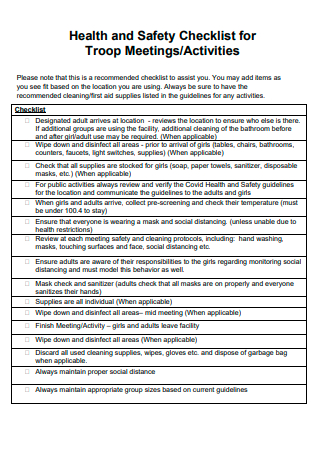
Troop Meetings Health and Safety Checklist
download now -

Day Camp Health and Safety Checklist
download now -

Draft Health and Safety Checklist
download now -

Occupational Health and Safety Checklist
download now -
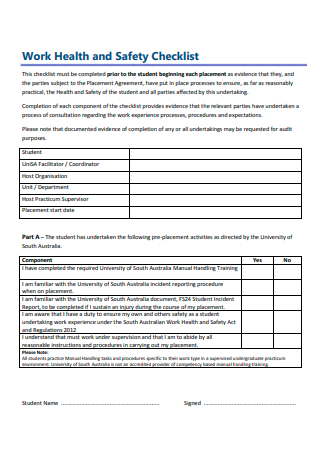
Work Health and Safety Checklist
download now -

Health and Safety Guidance Checklist
download now -

Health and Safety Plan Checklist
download now -

Workplaces Health and Safety Checklist
download now -

Quarterly Health and Safety Meeting Checklist
download now -

Health and Safety Checklist For Redeployment
download now -

Studio Health and Safety Checklist
download now -

An employee of Record Health and Safety Checklist
download now -

Sample Health and Safety Checklist
download now -

Student Health and Safety Documentation Checklist
download now -

Health and Safety Management Checklist
download now -

Child Care Centers Health and Safety Checklist
download now -

Teaching Rooms Health and Safety Checklist
download now -

Football Coaching Health and Safety Checklist
download now -
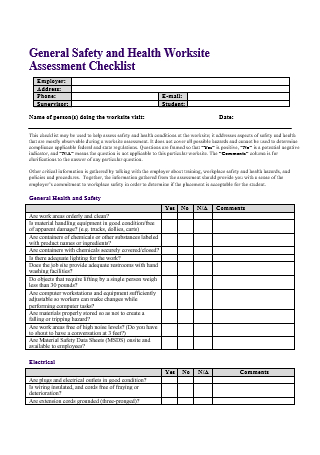
Health and Safety Worksite Assessment Checklist
download now -
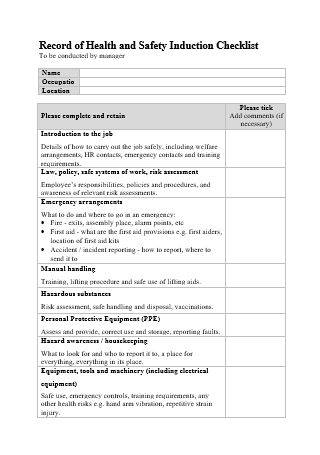
Record of Health and Safety Induction Checklist
download now -

Health and Safety Committee Compliance Checklist
download now -
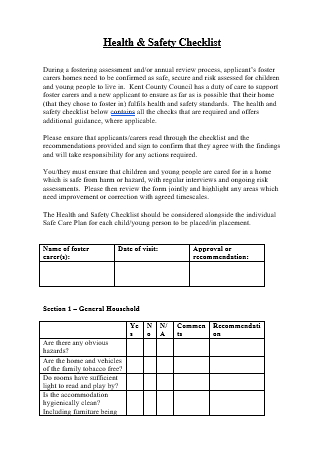
Health and Safety Checklist in DOC
download now
FREE Health and Safety Checklist s to Download
Health and Safety Checklist Format
Health and Safety Checklist Samples
a Health and Safety Checklist?
Purposes of a Health and Safety Checklist
How to Create a Health and Safety Checklist
FAQs
Why do we require security?
What constitutes an effective safety minute?
Why do safety toolboxes communicate with one another?
How does a Health and Safety Checklist improve workplace safety?
What should a comprehensive Health and Safety Checklist include?
How do digital Health and Safety Checklists enhance efficiency?
What role do employees play in using a Health and Safety Checklist?

Download Health and Safety Checklist Bundle
Health and Safety Checklist Format
Location: [Specify location]
Date: [Insert date]
Inspector(s): [Insert name(s)]
Department/Area Inspected: [Specify area or department]
1. General Workplace Safety
| Item | Description | Yes/No/NA | Notes/Action Required | Completed By | Completion Date |
|---|---|---|---|---|---|
| 1.1 | Floors are clean, dry, and hazard-free | ||||
| 1.2 | Emergency exits are clearly marked and accessible | ||||
| 1.3 | Adequate lighting throughout the workspace |
2. Fire Safety
| Item | Description | Yes/No/NA | Notes/Action Required | Completed By | Completion Date |
|---|---|---|---|---|---|
| 2.1 | Fire extinguishers are accessible and inspected | ||||
| 2.2 | Fire alarms are functional and tested regularly | ||||
| 2.3 | Emergency evacuation plan is posted and up to date |
3. Equipment Safety
| Item | Description | Yes/No/NA | Notes/Action Required | Completed By | Completion Date |
|---|---|---|---|---|---|
| 3.1 | Tools and equipment are in good condition and inspected | ||||
| 3.2 | Proper personal protective equipment (PPE) is provided and used | ||||
| 3.3 | Machinery has safety guards in place and operational |
4. Chemical and Hazardous Materials
| Item | Description | Yes/No/NA | Notes/Action Required | Completed By | Completion Date |
|---|---|---|---|---|---|
| 4.1 | Chemicals are stored in labeled containers | ||||
| 4.2 | Material Safety Data Sheets (MSDS) are available and up to date | ||||
| 4.3 | Proper disposal procedures are followed for hazardous materials |
5. First Aid and Emergency Preparedness
| Item | Description | Yes/No/NA | Notes/Action Required | Completed By | Completion Date |
|---|---|---|---|---|---|
| 5.1 | First aid kits are stocked and accessible | ||||
| 5.2 | Emergency contacts and procedures are posted | ||||
| 5.3 | Employees are trained in basic first aid and CPR |
6. Other Observations
| Description | Notes/Action Required | Completed By | Completion Date |
|---|---|---|---|
Signatures
Inspector(s):
[Name/Signature]
Manager/Supervisor:
[Name/Signature]
Health and Safety Board Checklist
What is a Health and Safety Checklist?
A Health and Safety Checklist is a structured document that outlines key items, tasks, and checks to identify hazards, ensure compliance with safety regulations, and promote a secure workplace. These checklists help assess risks, track improvements, and document findings during inspections. They are used across industries such as construction, healthcare, and manufacturing to maintain high safety standards and protect employees and visitors. You can also see more on Field Inspection Checklist.
Purposes of a Health and Safety Checklist

A Health and Safety Checklist serves as a foundational tool for creating and maintaining a safe workplace environment. Its purposes include:
1. Identifying Hazards and Risks
The checklist helps organizations pinpoint potential hazards, such as unsafe equipment, poor ergonomics, or fire risks, ensuring proactive risk management.
2. Ensuring Regulatory Compliance
By addressing safety standards set by authorities (e.g., OSHA, ISO), the checklist ensures businesses meet legal requirements, avoiding fines and penalties. You can also see more on Work Checklists.
3. Streamlining Safety Inspections
Checklists provide a structured approach to inspections, ensuring consistency and thoroughness while saving time and resources.
4. Promoting a Safety Culture
Regular use of the checklist fosters awareness and accountability among employees, encouraging a workplace culture where safety is prioritized.
5. Documenting Safety Practices
The checklist serves as a record of safety inspections, compliance efforts, and corrective actions, which can be invaluable for audits, insurance claims, or legal disputes. You can also see more on Workplace Inspection Checklist.
How to Create a Health and Safety Checklist

Creating a comprehensive Health and Safety Checklist is essential for maintaining a safe workplace. Follow these detailed steps to design an effective checklist:
Step 1: Understand Workplace Needs
Begin by conducting a thorough assessment of your workplace to identify potential hazards. Consider specific risks such as chemical exposure, machinery operation, or fire safety requirements. Consult industry regulations, employee feedback, and past incident reports to gain a full understanding. Use this information to tailor the checklist to your workplace’s unique requirements. A well-informed foundation ensures your checklist addresses all critical safety areas. You can also see more on Office Checklist.
Step 2: Organize the Checklist into Categories
Divide the checklist into distinct categories for clarity and ease of use. Examples include fire safety, equipment safety, emergency preparedness, and personal protective equipment (PPE). This segmentation ensures all aspects of workplace safety are systematically covered. Each category should address specific tasks or inspections relevant to its focus area. Clear organization makes the checklist user-friendly and minimizes the chances of oversight.
Step 3: Detail Specific Items for Inspection
Within each category, list actionable items to be checked during inspections. For instance, in the fire safety category, include testing smoke detectors, inspecting extinguishers, and ensuring exits are clear. Be precise in your descriptions to eliminate ambiguity and guide inspectors effectively. Use language that is easy to understand, even for individuals unfamiliar with technical terms. Comprehensive itemization ensures thoroughness and reliability during safety audits.
Step 4: Design a User-Friendly Format
Create a layout that is simple and functional, incorporating columns for tasks, statuses (e.g., pass/fail), assigned personnel, and comments. Ensure the checklist can be used in both digital and print formats, depending on workplace needs. Use visual aids like checkboxes or dropdown menus for convenience and quick reference. A clear design enhances usability and reduces the chances of errors during inspections. Digital tools can further streamline data entry and reporting. You can also see more on Inspection Checklists.
Step 5: Test, Review, and Update Regularly
Conduct a trial run to test the checklist’s effectiveness in a real inspection scenario. Gather feedback from employees and safety officers to identify gaps or redundant tasks. Revise the checklist based on this feedback and ensure it complies with updated regulations and workplace changes. Regularly review and update the checklist to maintain its relevance and effectiveness. Continuous improvement keeps the checklist aligned with evolving safety standards
FAQs
Why do we require security?
Not only does a safe and healthy workplace protect employees from injury and illness, but it can also help reduce injury and illness costs, absenteeism and turnover, boost productivity and quality, and boost employee morale. In other words, business benefits from safety. Additionally, protecting employees is the moral thing to do.
What constitutes an effective safety minute?
A safety moment should not exceed ten minutes in duration. It can occur at any time: at the start of a shift, during the day, or following a non-safety meeting or event. Make it informal and encourage group interaction, which is an excellent way to engage employees. You can also see more on Home Safety Checklist.
Why do safety toolboxes communicate with one another?
Toolbox presentations are an excellent method to reaffirm safety fundamentals, focus on high-risk scenarios, and tell employees about any changes to the job site or working circumstances that may have occurred since their last shift. Discuss any incidents or injuries that happened and how they could have been avoided.
How does a Health and Safety Checklist improve workplace safety?
By systematically identifying and mitigating risks, it reduces the likelihood of accidents. Regular use fosters a proactive safety culture, helping organizations address hazards before they become issues. You can also see more on Employer Safety Checklist.
What should a comprehensive Health and Safety Checklist include?
It should cover equipment maintenance, emergency preparedness, employee training, hazard identification, and compliance checks. The content depends on the workplace’s specific needs and risks.
How do digital Health and Safety Checklists enhance efficiency?
Digital checklists offer real-time updates, easy sharing, and automation of reports. They reduce paperwork and allow for seamless tracking and compliance monitoring. You can also see more on Health Checklists.
What role do employees play in using a Health and Safety Checklist?
Employees contribute by identifying hazards, reporting issues, and following checklist protocols. Their involvement ensures practical insights and effective implementation.
